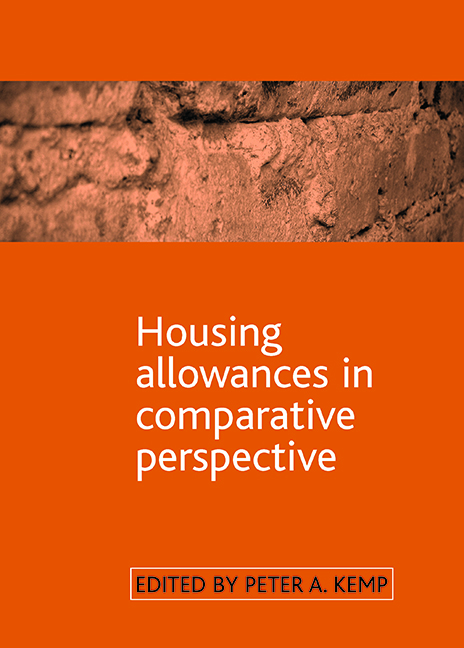Book contents
- Frontmatter
- Contents
- List of tables and figures
- Acknowledgements
- Notes on contributors
- one Housing allowances in context
- two Housing allowances and the restructuring of the Australian welfare state
- three The New Zealand experience of housing allowances
- four Canadian housing allowances
- five Housing allowances American style: the Housing Choice Voucher programme
- six Housing Benefit in Britain: a troubled history and uncertain future
- seven Housing allowances in France
- eight Housing allowances in Germany
- nine Housing allowances in the Netherlands: the struggle for budgetary controllability
- ten Housing allowance systems in Sweden
- eleven Housing allowances in the Czech Republic in comparative perspective
- twelve Housing allowances in the advanced welfare states
- Index
seven - Housing allowances in France
Published online by Cambridge University Press: 15 September 2022
- Frontmatter
- Contents
- List of tables and figures
- Acknowledgements
- Notes on contributors
- one Housing allowances in context
- two Housing allowances and the restructuring of the Australian welfare state
- three The New Zealand experience of housing allowances
- four Canadian housing allowances
- five Housing allowances American style: the Housing Choice Voucher programme
- six Housing Benefit in Britain: a troubled history and uncertain future
- seven Housing allowances in France
- eight Housing allowances in Germany
- nine Housing allowances in the Netherlands: the struggle for budgetary controllability
- ten Housing allowance systems in Sweden
- eleven Housing allowances in the Czech Republic in comparative perspective
- twelve Housing allowances in the advanced welfare states
- Index
Summary
Introduction
For most of the past 60 years, France has had two housing allowance regimes, one for market-priced housing and one linked to the country's intricate system of housing capital subsidies. Neither allowance regime has paid 100% of housing costs. How has this system evolved? What are its market impacts and distributional consequences? This chapter presents a review of the main features of the French system of income-related housing allowances; it identifies the context of that system in the country's welfare state and then looks at the design of the system and how it is intended to operate. The third main section looks at the key impacts of housing allowances in France. The chapter then discusses evidence for the failings of the system and the concluding section summarises the main points discussed.
France's population is estimated to have been 62.2 million in mid-2004, some 5.5 million higher than 20 years earlier (INSEE, 2005). Its population density is less than that of many of its European neighbours and about a quarter of the population lives in rural areas (a similar number to those in the three main metropolitan regions centring on Paris, Lyon and Marseille/Aix-en-Provence). The mean age of the country's population is currently estimated at between 39 and 40, about four years older than at the end of the Second World War and seven years older than at the start of the last century (INSEE, 2005). Around one person in 10 living in France was not born in the country, with about half of these having been naturalised as French citizens. About a quarter of France's 24 million households are couples without children, about a third are couples with children and slightly fewer than one in three are comprised of a single person. There are around 2 million lone-parent families.
Figure 7.1a shows how average disposable incomes have changed over the past 30 years in real terms. From 1970 to 1990 there was rapid and then slightly more modest growth with real falls until 1997, followed by renewed growth (to the 2002 mean of €27,300 and median of €24,000). Unsurprisingly, disposable incomes are higher for non-pensioner households than for pensioners (€30,000 compared to €21,500 at the mean), with households headed by a person aged 40–49 the most well-off (mean €34,000).
- Type
- Chapter
- Information
- Housing Allowances in Comparative Perspective , pp. 135 - 158Publisher: Bristol University PressPrint publication year: 2007

